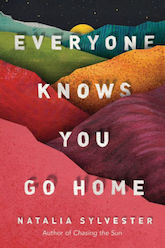I always knew that the main character in my novel would be dead. When I started writing, I didn’t know how he died or why, but I knew the sound of his voice and the kind of jokes he’d make, the way his eyes smiled even when his lips didn’t.
I also knew, even in those very early stages, that Everyone Knows You Go Home would not be magical realism. I knew because I loved and studied and have been deeply influenced by magical realism. Two of the books I most love in the world—Isabel Allende’s The House of the Spirits and Gabriel García Márquez’s Love in the Time of Cholera—are often used as prime examples of the genre, which fuses magical or fantastical elements into an otherwise realistic story in a very nonchalant fashion. The how or why of the supernatural in these works is never the point; they exist as matter-of-factly as air or the sun, and in turn they illuminate truths in reality that we may miss otherwise. The inexplicable, bizarre nature of the unreal reflects on the inexplicable, bizarre nature of the real.
In Latin American magical realism, which the term is most often associated with, there’s often a deep connection between the magic in the writing and the magic in the writer’s life, roots, and culture. Dahlma Llanos-Figueroa, author of Daughters of the Stone, explains these dynamics beautifully on her website: “I was born into a world of stories full of color and warmth and tragedy and magic and humor. I was born into a world of music and intuitive knowing and overpowering scents. But when I went to school, I was told that reason and logic were the only acceptable ways of knowing. Emotions clouded reality. Definitions had to be exact, measurable, black and white, no in-betweens.”
Buy the Book


Everyone Knows You Go Home
Like Llanos-Figueroa’s work, my novel was borne of the in-betweens. It’s the story of the spirit of a man who visits his son and daughter-in-law on the day of their wedding, which also happens to be the Day of the Dead. When Omar first appears to Martin and Isabel, Martin won’t even talk to him. Having been estranged from his father nearly his whole life, Martin is unconcerned with the why or how of Omar’s manifestation. Instead, over time, Isabel becomes the only one who will speak to Omar or see him; she’s drawn to his spirit for the family secrets he represents. Year after year, as Omar visits Isabel each Day of the Dead (and wedding anniversary) the two develop a special bond that begins to shed light on the cracks in the foundation of her new marriage. Set in the Rio Grande Valley on the border between Texas and Mexico, the story delves into physical and spiritual borders to explore immigration, familial bonds, and the in-between spaces we get caught in as we try to make a home.
And yet, I don’t consider it magical realism. As much as I can see why it’s often described as such—terms like supernatural or fantastical are sometimes used, too—there’s a hugely important distinction in why it’s not.
For it to be magical realism or fantasy or supernatural, it’d have to actually include elements so removed from reality or nature that they’re fantastical. But what happens when the so-called magic is not a departure from reality, but rather a very real connection to your culture? What happens when it’s not fantasy at all, but rather a cultural tradition that dates back millennia, and continues to be celebrated today?
Omar’s spirit never came to me as an extraordinary occurrence. I’m careful not to use the word “ghost,” which hints at the supernatural, because to me, the idea that our ancestors continue to be with us, long after their deaths, is a very natural one.
It’s why no one seems at all surprised to see Omar. It’s why no one questions why he visits. The Day of the Dead is rooted in ancient indigenous beliefs that once a year, the spirits of one’s deceased are able to cross back into the world of the living to reunite with their family for 24 hours. With origins in Central America, today it’s also celebrated in parts of South America and in the US amongst Latinx communities. It’s a time of celebration and remembrance, of honoring your loved ones that have passed.
I chose to take El Dia de Los Muertos literally in my novel, not because it’d seem supernatural, but precisely the opposite. When Omar visits Isabel a second time, the only explanation he chooses to offer is this: “Do you know what keeps the dead from really dying, Isabel? It’s just memory. Longing. Being held in the hearts of our loved ones.”
I’ve found the reactions to this non-explanation interesting and very telling. To readers who are Latinx or from cultures that treat death in similar ways—not fearing the spirits, but embracing their presence—there’s an immediate knowing and understanding. To many native-born, white US readers, the story is either refreshing in its nonchalant treatment of the spiritual, or it’s frustrating in that it doesn’t veer more into a fantasy world. Within these two contexts, terms like speculative fiction, fantasy, and magical realism become very loaded, because they reveal a reader’s expectations of how a story with a dead character should be written, and for whom it should written.
For each reader who finds it disorienting or even exotically exciting that the spirit of a loved one appears with little fanfare, there’s a reader who recognizes and relates to this deep connection to their dead. I embrace both reactions. I embrace the discomfort a reader may feel at not having a story specifically tailored to their culture and perspective, especially in an industry that is predominantly white and therefore, often tailored to a white reader’s comfort level. I hope they welcome the discomfort, too, and all the ways they can learn and grow from it.
Most of all, I welcome the reader who may see themselves, their culture, and their family in a story that doesn’t treat this experience as particularly “other.” I hope it feels familiar. I hope it feels like home.
Natalia Sylvester is the author of the novels Chasing the Sun, which was named the Best Debut Book of 2014 by Latinidad, and Everyone Knows You Go Home, which was named a Best Book of 2018 by Real Simple. She studied Creative Writing at the University of Miami and is a faculty member of the low-res MFA program at Regis University in Denver, Colorado. Born in Lima, Peru, she came to the U.S. at age four and spent time in South and Central Florida and the Rio Grande Valley in Texas before her family set roots in Miami. She now lives and works in Austin.










